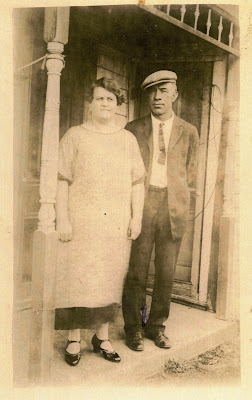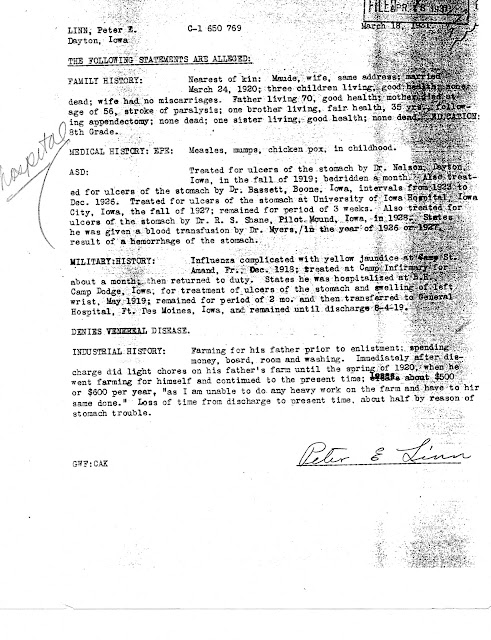My grandparents, Peter and Maude Linn, didn’t own their farm
south of Dayton, Iowa. But what was the nature of their lease? Were they cash
renters, tenant farmers, or sharecroppers? From the time they married in 1920
until they moved in the late 1940’s, they farmed the 160 acres and lived in a
house that had no running water or reliable electricity.
In 1948, Peter and Maude Linn, along with their 3 youngest
boys, moved from the farm near Dayton to 1615 Arlington Avenue, in Des Moines.
A large, stately house set on a large lot, this part of Des Moines had been the
area in which the rich and well-connected professionals had lived in previous
decades. They rented rooms to lodgers, and the 1950 US Federal Census shows
Peter, Maude, sons Ellis, Ivan, and Merlyn, and NINE lodgers.
So, what became of the farm 2 miles south of Dayton? As a
Litchfield Farm, another renter/sharecropper was needed. That’s when my family
moved in and started to farm. But were we renters, tenant farmers, or
sharecroppers?
At the bottom of this post is a lease agreement link for the Litchfield farm made
between my parents and Litchfield. You may not be able to read all of the
details, but let’s look more closely at a few important parts to this 1956-57
agreement. The property consisted of 160 acres, some of it forested, some
pasture, and some cultivated land.
You may see the words “Crop Share” under RENTAL toward the
top of the page. Before reading on, let’s learn about the differences among
share croppers, renters, and tenant farmers:
In Iowa, many of the farmers were tenant farmers, meaning
they likely paid part of the rent in cash and part to the owner in crops; and they
sometimes were called “share croppers”. While the words tenant farmer
and share cropper were used interchangeably, there were differences,
depending on the contract that was written. A true sharecropper was considered
to be the “poorest of the poor” in that they provided ONLY labor for the owner
of the property. They were unlikely to ever be able to move up or out, never be
able to buy their own land or make any real money. They had to use the seeds
and equipment provided by the owner, plant what the owner demanded, and pay for
their living arrangements with a percentage of the crops.
A cash renter was just that. The rent agreement was paid
solely in cash. The crops, and money for those crops, were those of the renter,
whether it was a good year or a bad year.
By contrast, a tenant farmer's contract usually contained provisions for both cash rent plus a share of the crops with the landlord. A good year was good for both; a bad crop year (caused by disease, drought, early winter, or other reasons) was bad for both. In even the best of situations, sharecropping families lived in a house and on land that was not their own and, without any notice, they could be evicted by their landlord. In addition, like the "company store" of Tennessee Ernie Ford's song, sharecroppers could be forced to pay elevated prices for seed or pasture land and split any profits in an unfair way. On the other hand, a tenant farmer's agreement normally called for notice to the farmer to vacate the land; and the same was true for a cash renter.
Often
we see in an obituary or in a life sketch that a person was the son or grandson
of sharecroppers. You may think, as I did, that sharecroppers were only, or primarily, black? However,
approximately two-thirds of all sharecroppers in the United States were white, and one third were black. However, both groups were at the bottom of
the economic ladder.
By
the 1940s—with increased mechanization and better-paying jobs in urban
areas—sharecropping began to disappear in the United States, though some form of it still exists in a
handful of areas.
Sharecropping, however, is routinely practiced today in a few countries such as
Bangladesh, Ghana, Zimbabwe, India and Pakistan.
Of all acres in Iowa as of July 1, 2022, 7 percent were said to be under a crop sharing agreement which represented 12 percent of all leased land in Iowa.
So, what happened to these renters or sharecroppers during the Great Depression?
My mother always said that her family and her other
relatives fared well during the Great Depression. They had plenty of food and
animals and were able to keep their economic heads above water. But they
actually OWNED their farms.
But for those who had high mortgages or didn’t own,
including Peter and Maude Linn, what happened to them during the Great
Depression? In general, farmers did struggle with lower prices, and, at some
point, may not have been able to pay the rent on their farm or hire laborers
for various jobs around the farm. I learned that Peter Linn (my grandfather)
found that he couldn’t make any money by selling the pigs he had raised and was
ready to just slaughter them all to have the meat and to stop the cost of their
feed and upkeep. He was talked out of that at the time. But many farmers were
making desperate decisions IF they were not able to keep up with
the rent and other costs.
Some farmers in Iowa became so angry that they blockaded the
transfer of milk to cities and towns, hoping that might drive the price up. In
some cases, the price for a bushel of corn fell to just 7 or 8 cents. And
during this time, some farmers declared bankruptcy.
Peter Linn, as a renter, and other farmers in our family who
rented, felt the pressures of the Great Depression.
Farmers Grow Angry and Desperate:
The
Great Depression Hits Farms and Cities in the 1930s | Iowa PBS
The Great Depression Hits Farms and Cities:
https://www.iowapbs.org/iowapathways/mypath/2591/great-depression-hits-farms-and-cities-1930s
Continuing the look at the agreement between Litchfield and
my family in 1956, there is a section covering “who pays for what”. In our
case, the following were included:
Tenant is to deliver at the Dayton or Wolf Station free of
charge, in elevator, crib, or car, one-half of all corn, two-fifths of all oats
and soy beans, and one-half of all other grain raised on the leased premises as
lessor may direct. [We were paying in crops.]
Tenant pays one-half of cost of hybrid seed corn. Tenant
furnishes all seed other than corn. [Somewhat of a split on corn seed.]
Tenant pays cost of threshing or combining oats and soy
beans. Each party pays one-half of all other threshing. [A shared cost.]
Tenant pays $35.00 for pasture rent, $5.50 for meadow rental
per acre for one cutting and $10 per acre for two or more cuttings.
Tenant agrees that he shall not be entitled to any
compensation for buildings, repairs or other improvements … unless expressly
consented to by lessor beforehand in writing.
There is much more to learn about these farm arrangements,
but based on what you have read and your look at the 1956-57 agreement between
Litchfield and my family, what do you think? Were we renters, tenant farmers,
or share croppers?





























.jpg)
